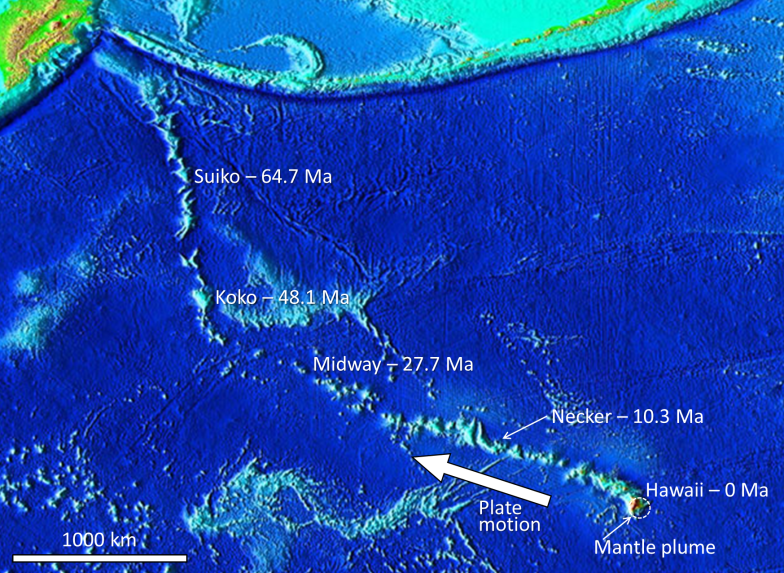4.9 Seamounts and Hot Spots
Modified from "Physical Geology" by Steven Earle*
The ocean floor is dotted with seamounts, some isolated and some in chains. Seamounts are underwater volcanoes, and most are much younger than the oceanic crust on which they formed. If a seamount gets large enough to break the ocean surface, it becomes a volcanic island. Some seamounts are formed from magma rising at a divergent boundary, and as the plates move apart, the seamounts move with them, which can result in a seamount chain. Other seamounts form from the rising magma at an ocean-ocean subduction zone; these include the Aleutians, extending from Alaska to Russia, and the Lesser Antilles in the eastern part of the Caribbean. Sometimes the crust on which an island or seamount sits will subside, taking the seamount with it. As this happens, the top of the seamount can become eroded flat, and these flat-topped seamounts are then called tablemounts or guyots.
However, some seamounts are formed far away from plate boundaries, in places where we would not usually expect much volcanic activity. Some seamounts and ocean islands are formed above a mantle plume or hot spot — a place where hot mantle material rises in a stationary and semi-permanent plume, and affects the overlying crust. Mantle plumes are thought to rise at approximately 10 times the rate of mantle convection. The ascending column may be on the order of kilometers to tens of kilometers across, but near the surface it spreads out to create a mushroom-style head that is several tens to over 100 kilometers across. Near the base of the lithosphere (the rigid part of the mantle), the mantle plume (and possibly some of the surrounding mantle material) partially melts to form magma that rises to feed volcanoes.
A great example of seamounts created from a hot spot includes the Hawaiian and Emperor Seamount island chains in the Pacific Ocean (Figure 4.9.1). The oldest of the Hawaiian/Emperor seamounts is dated at around 80 Ma, and it is situated on oceanic crust aged around 90 to 100 Ma. The volcanic rock making up these islands gets progressively younger toward the southeast, culminating with the island of Hawaii itself, which consists of rock that is almost all younger than 1 Ma. It appears that a stationary plume of hot upwelling mantle material is the source of the Hawaiian volcanism, and that the ocean crust of the Pacific Plate is moving toward the northwest over this hot spot. A seamount will be formed through volcanic activity over the hot spot, then the plate will move and displace the seamount before the hot spot produces the next seamount, and so on. In this way, over time, the seamounts are formed in chains. Near the Midway Islands, the chain takes a pronounced change in direction, from northwest-southeast for the Hawaiian Islands to nearly north-south for the Emperor Seamounts. This change is widely ascribed to a change in direction of the Pacific Plate moving over the stationary mantle plume, but it is also possible that the Hawaiian mantle plume has not actually been stationary throughout its history, and in fact moved at least 2,000 km south over the period between 81 and 45 Ma.

Since most mantle plumes are beneath the oceans, the early stages of volcanism typically take place on the seafloor. Over time, very large islands may form like those in Hawaii. In fact, if you measure it from its base on the seafloor to its summit, Mauna Loa on the island of Hawaii is the largest mountain on Earth, rising 9700 m (in comparison, the elevation of the summit of Mt. Everest is 8848 m). While the island of Hawaii is the youngest in the chain, there is actually a new volcano named Loihi, that is still submerged at a depth of 980 m SE of Hawaii, and may one day become a new Hawaiian island when it emerges 10,000 – 100,000 years from now.
There is evidence of many such mantle plumes around the world. Most are within the ocean basins, including places like Hawaii, Iceland, and the Galapagos Islands, but some are under continents. One example is the Yellowstone hot spot in the west-central United States, and another is the one responsible for the Anahim Volcanic Belt in central British Columbia. It is evident that mantle plumes are very long-lived phenomena, lasting for at least tens of millions of years, possibly for hundreds of millions of years in some cases.
a submerged mountain rising from the seafloor (4.9)
the Earth’s crust underlying the oceans (as opposed to continental crust) (3.2)
a plate boundary at which the two plates are moving away from each other (4.5)
the sloping region along which a tectonic plate descends into the mantle beneath another plate (4.6)
a flat-topped seamount (also called a guyot) (4.9)
a flat-topped seamount (also called a tablemount) (4.9)
a plume of hot rock (not magma) that rises through the mantle (either from the base or from part way up) and reaches the surface where it spreads out and also leads to hot-spot volcanism (4.9)
the surface area of volcanism and high heat flow above a mantle plume (4.9)
movements in the mantle from rising and sinking mantle material as it heats and cools (4.3)
the rigid outer part of the Earth, including the crust and the mantle down to a depth of about 100 km (3.2)
(Megaannus) millions of years before the present

